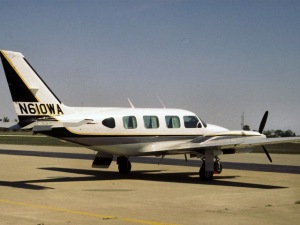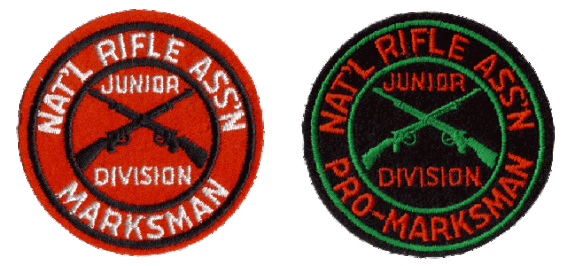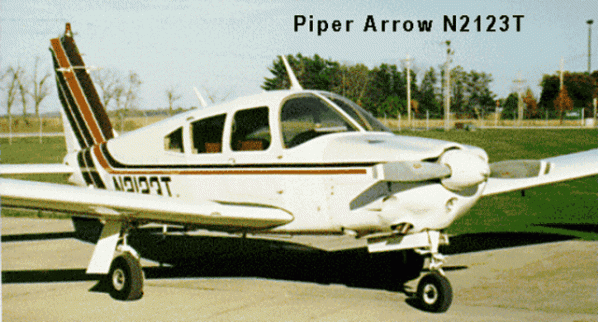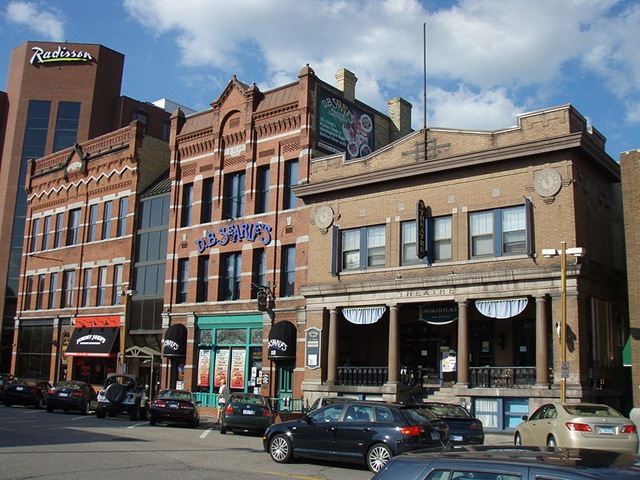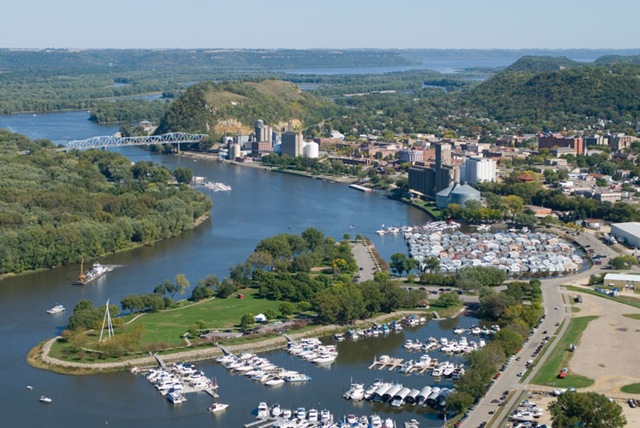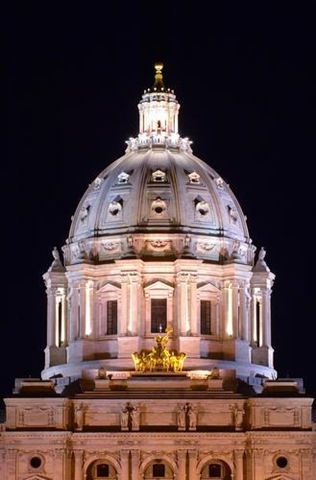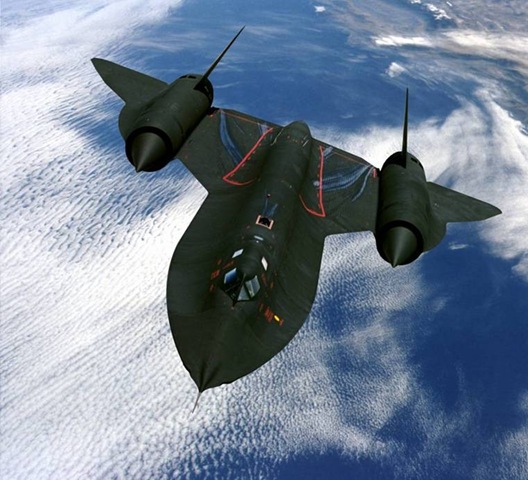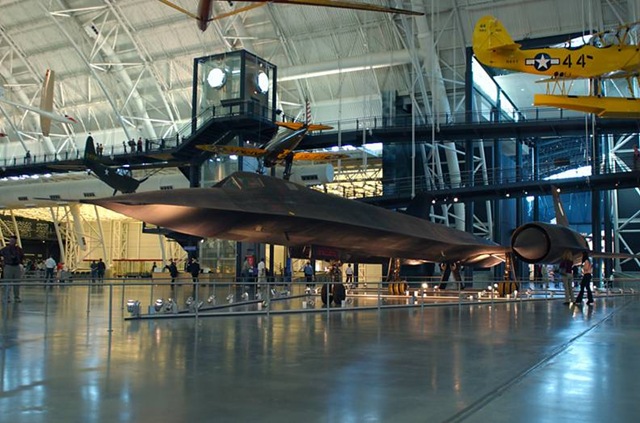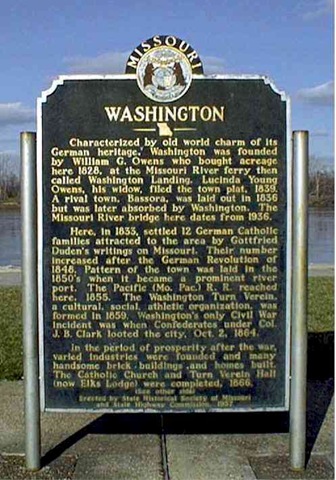Archive for the ‘Flying’ Category
Flying High and fast – Volume II Chapter 36 – Boston Massachusetts
JJ Meehan
mfmeehan@live.com
WEB Site
The Meehan Family
Sometime in the late 1980’s I got a call from Dick Novetzke asking if I could fly the President of DC Taylor and 4 other executives to Springfield, Massachusetts the following week. I had visions of the Boston POP and said yes. I then cancelled all my appointments and took 3 days off work.
We plan to leave early on Monday morning and return late on Wednesday. The weather was forecasted as excellent for the whole time that summer. My plans were to drop the DC Taylor Executives off in Springfield Massachusetts and then fly over to Boston to spend the next two nights. I love history and enjoyed growing up in near Alexandria, Virginia at Ft. Belvoir which is just five miles from George Washington’s Home – Mt. Vernon. In fact I attended Mt. Vernon High for two years. Over the years I managed to visit most of the museums and historical places in the Virginia area but Boston is still my favorite. To me this is truly the home of our nation. You have Paul Revere, John Adams, John Kennedy’s Museum, Concord, Lexington, Bucker Hill, The Commons, USS Constitution (Old Ironsides) the Salam Witch Trials, and much more.
I like Chicago but Boston is my favorite place – I love it. The following will not due Boston or my trip justices but I can tell you that I loved every minute and the weather was fantastic. In the 36 hours I had in Boston I managed to visit as many places as possible. Let’s start at the beginning. We agreed to meet at the Cedar Rapids Airport at 5:30 am. I had planned the flight non-stop to Springfield and it would take about 4 1/2 hours. The following was the route of our flight. The route of flight would be north of Chicago over Milwaukee, Wisconsin Saginaw, Michigan Niagara Falls, NY and then Springfield and Lexington MA. I decided to land at Lexington instead of Boston Logan so that I could get out without delays on Wednesday. In addition, I wanted to visit Lexington, Concord and Salam.
As I mentioned we met at the Cedar Rapids Airport at 5:30 am and departed just before 6:00 am CST. The weather was perfect and the flight was one of the smoothest and longest I’ve made. Later I’ll blog about a flight to Main that was longer but in all cases this  flight had the longest legs of any flight since the plane could hold 6 hours of fuel and the weather did not require us to include an alternate. We were able to fly non-stop from Cedar Rapids to Springfield, Massachusetts. The flight was over some of my favorite places, Milwaukee, Wisconsin, Saginaw, Michigan and Niagara Falls, New York. The flight was over lake Michigan for about 140 miles. This is probably the widest place on Lake Michigan. I’ve flow this route hundreds of times in the process of getting to Saginaw and the eastern shores of Lake Michigan. I had only flow over Canada and Niagara Falls one other time. This trip is covered in Vol. II Chapter 8 – Michigan and Niagara Falls, NY. As I mention in Chapter 8, the roads and farm sections in Canada can give you a vertigo sensation since they are not true north or magnetic north but run at 30 to 40 degree angles to true (magnetic) north. Anyway it is beautiful county and seeing Niagara Falls from the air is always fantastic. This time I even took the time to fly a circle around the falls. The falls are beautiful. The picture at the right is off the Internet.
flight had the longest legs of any flight since the plane could hold 6 hours of fuel and the weather did not require us to include an alternate. We were able to fly non-stop from Cedar Rapids to Springfield, Massachusetts. The flight was over some of my favorite places, Milwaukee, Wisconsin, Saginaw, Michigan and Niagara Falls, New York. The flight was over lake Michigan for about 140 miles. This is probably the widest place on Lake Michigan. I’ve flow this route hundreds of times in the process of getting to Saginaw and the eastern shores of Lake Michigan. I had only flow over Canada and Niagara Falls one other time. This trip is covered in Vol. II Chapter 8 – Michigan and Niagara Falls, NY. As I mention in Chapter 8, the roads and farm sections in Canada can give you a vertigo sensation since they are not true north or magnetic north but run at 30 to 40 degree angles to true (magnetic) north. Anyway it is beautiful county and seeing Niagara Falls from the air is always fantastic. This time I even took the time to fly a circle around the falls. The falls are beautiful. The picture at the right is off the Internet.
We had just managed to complete 2 1/2 hours when we flow over Niagara Falls and we still had 2 hours of flying time. to Springfield, Massachusetts. I was the only pilot on board and had to maintain my position at the controls for all 4 1/2 hours. Needless to say I did use what they call a Jill’s John to relieve myself several times. There was a potty chair in the back for the passengers. There was one lady on board and she was pretty cool about the whole operation. My bladder has never been able to hold much for long. If you have ever flow to Hawaii or from New York to LA you will have a sense of how long the flight felt. Normally I plan my flights for 2 1/2 to 3 hours max but in this case they had meetings and a schedule to meet. For me it was an adventure.
We landed in Springfield at 11:30 am EST. All the passengers headed to the restrooms and I had the ground service clean and replace the liner to the potty on the plane. I also had them fuel the plane and arranged to pick up the Executives at 6:00 pm EST on Wednesday. Normally I would give you a little back ground on the area but since was only at the airport in Springfield and have no personal contact, I will not bore you with a repeat of Wikipedia. You can read about Springfield, MA if you wish at http://en.wikipedia.org/wiki/Springfield,_Missouri. Wish I had more time to visit the area but many some other time.
After I made sure they were on their way with their contacts in Springfield I climbed back into N610WA and headed to Boston (Lexington), Massachusetts. The flight time to Lexington would be just over an hour. I arrived just in time for lunch. I made sure the plane was taken care of and refueled for the fight on Wednesday afternoon and I headed to downtown Lexington for lunch. After lunch and a drive around Lexington I headed to Concord.
The following are a few photos of these two historical towns. I can remember reading about the Battles of Lexington and Concord in my history books – Now I was here. Both towns keep the small New England town atmosphere and both was very attractive today.
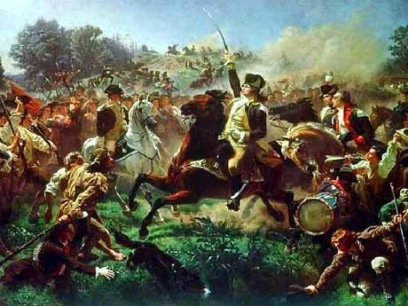 |
 |
 |
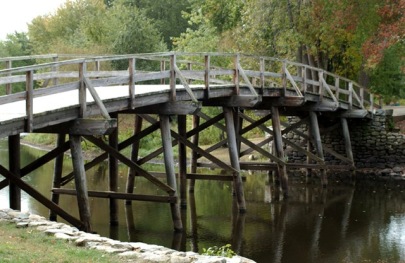 |
 |
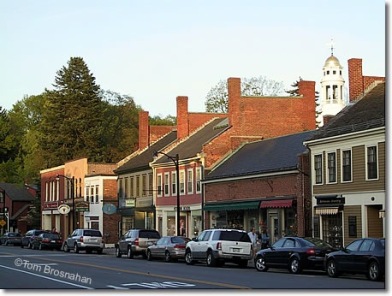 |
That night I had dinner at the “Barking Crap” on the Boston Lake Front. This restaurant was featured in the Movie “Game Plan”. The seafood was fantastic. I made reservation on the Executive Floor of the Holiday Inn for my stay in Boston. This was handy and allowed me to have access to most of the Boston Area.
 |
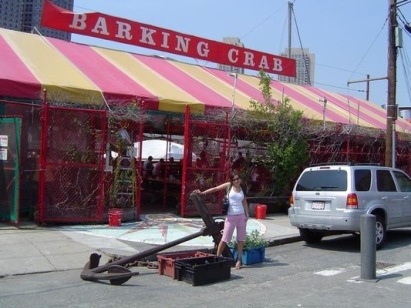 |
Early the next morning (Tuesday), I was on the go. I toured the downtown area including Boston Commons, Boston Massacre, The Old North Church, Bunker Hill, Paul Revere Home,
 |
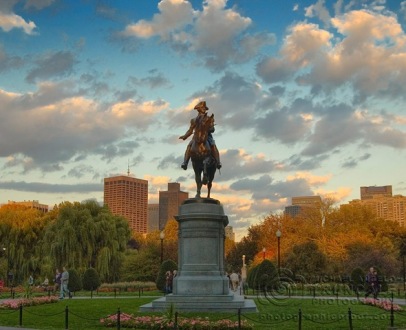 |
 |
 |
 |
 |
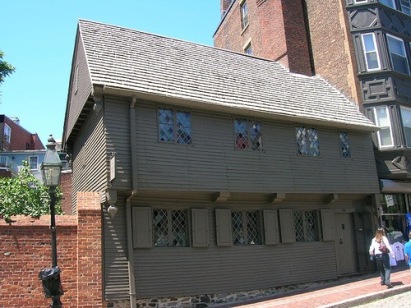 |
 |
 |
 |
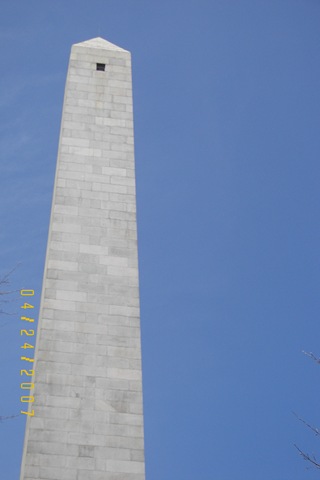 |
 |
 |
 |
After lunch at Warren Tavern, I drove about 30 miles south of Boston to Quincy to visit the John Adams Historical Site. John Adams was our 2nd President and his Site was worth the visit. You got to see his birth home and his pride and joy – Peacefield. Peacefield was originally constructed in 1731 for Leonard Vassall, a sugar planter, and was used as his summer house. The house stood empty for some time before it, along with 75 acres (30 ha), was purchased by Adams on September 23, 1787 for 600 pounds. The Adams’s family moved in the next year and occupied it until 1927, when it was sold to the Adams Memorial Society. The National Park Service acquired it in 1947, and has been a National Historic Site ever since. This library, on the grounds of Peacefield, is home to over 14,000 volumes which belonged to the Adams family. In his will, John Quincy Adams requested that the library be built out of stone so that it would be fireproof. The building was completed in 1870.
 |
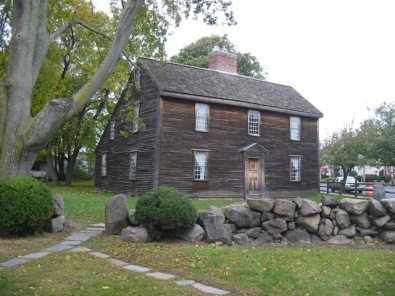 |
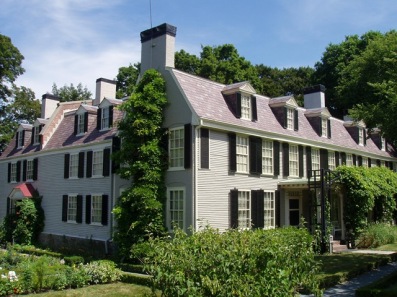 |
 |
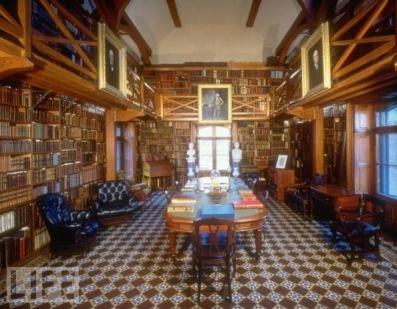 |
 |
By 4:00 pm I was rushing to get to the John F. Kennedy Library. I was lucky to have picked one of the few days that the Library would be open until 8:00 pm. In “Fly High and Fast” – Vol. II Chapter 22: Kansas, I tell about President Dwight D. Eisenhower Library. So far I’ve been able to visit all but one of the Presidential Libraries. President Lyndon B. Johnson (LBJ) Library in Austin Texas is the only Presidential Library we (Jeannie and I) have not seen. We live about 50 miles north of the President Herbert Hoover Library in West Branch, Iowa. If you get a chance, I would recommend visiting them. What fantastic treasures of information.
 |
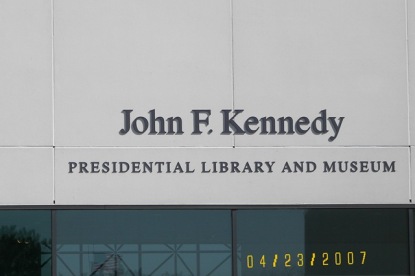 |
 |
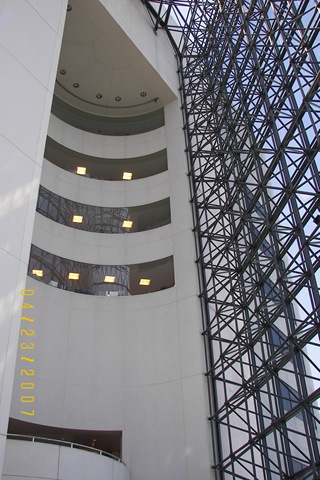 |
 |
 |
I was able to get last minute tickets to the Boston POP. No time for dinner and I was happy to make it back to Boston in time for the show.

What a day. I headed back to the hotel around 11:00 pm and after a quick drink and sandwich I was in bed. I slept until 10:00 am the next morning. After breakfast I headed over to the USS Constitution (Old Ironsides). I arrived just after 12:00 pm and rushed to get a few photos and tour the boat. I was in such a hurry that I left the car running and the door open. Not a very smart thing to do in Boston. When I got back about 30 minutes later, I found a gentlemen seating in the car. He turned out to be a Police Detective. After checking my license and verified that I the rental car was mine he told me that it was not very smart to leave a running car for 30 minutes in Boston. My only excuse which is really no excuse was that I was coming to the end of my magical trip and I wanted to take in as much as I could. I thanked him and head up to Salem.
 |
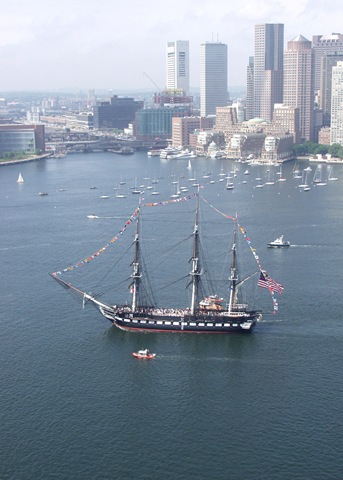 |
Salem, Massachusetts was my last stop before heading back to the airport. I wanted to see the city where the Salem Witch Trials were held and the House of the Seven Gables. I did not have time to go through either attraction but Jeannie and I did visit the Salem Witch Trial Museum on a vacation to Boston in 2007. Several of the pictures you see in this blog are from that trip.
 |
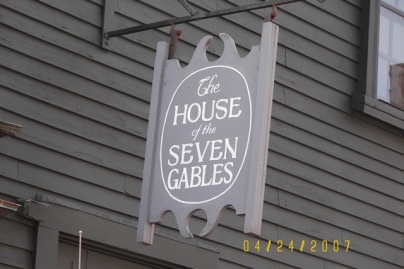 |
After a quick tour of the city of Salem, I headed back to the airport in Lexington, MA. I had called a head and they had been kind enough to get the plane ready for me. I checked the weather and filed two flight plans. The first was from Lexington, MA to Springfield MA and the second was from Springfield MA to Cedar Rapids, Iowa. I pre-flighted the plane and was airborne at 4:45 pm EST. I landed in Springfield at 5:50 pm and my passengers arrived around 6:30 pm. We departed for Cedar Rapids at 7:00 pm EST. Our route was just the reverse of our flight from Cedar Rapids to Springfield, MA. We did have a head wind. The flight took just over 5:00 hours and we landed at 1:00 am CST.
This was one of my favorite trips and one that I hope you have enjoyed. Please visit Boston when you have time.
You can find links to my other blogs on flying on my WEB Site – “Flying High and Fast”.
Please contact me with comments or questions at mfmeehan@live.com.
Written by jjmeehan13
June 27, 2010 at 4:15 pm
Posted in Flying
Fly High and Fast – Vol. II Chapter 35 – Medical Flight Willow Run Airport, Detroit, Michigan USA
JJ Meehan
mfmeehan@live.com
WEB Site
The Meehan Family
One winter day, I believe it was a Wednesday in 1988, I got a call from Wathan Flying Service asking if I could fly a medical flight to Detroit, Michigan USA. There was a patient needing transfer from a Detroit Hospital to the University of Iowa Hospital. I checked my schedule and told my Administrative Assistant to move two meetings and headed for the airport.
I spent the next hour checking the weather and filing my flight plan. The weather was bad. Low Ceilings 200 ft with 1/2 mile visibility at most airports along the route. I had to pick Memphis Tennessee for may alternate which had to be at least 1,500 ft and a mile visibility. Icing was reported along the route, mainly from aircraft taking off and landing. Detroit Metro was the closest large airport and it was below minimums. The only good news was that the ceilings were reported to be 5,500 ft for almost the whole route.
Willow Run use to be the main airport in Detroit and had been the Ford Assembly Plant for the B-24 (The Liberator) during World War II. You can watch a great video on the B-24 at “The Liberator”. This is an amazing story. They were able to produce a bomber every 55 minutes. Most of the assembly workers where women since the men were away fighting the war. My cousin, Grace Joan Nicholson Plant worked at the plant. You can read her story at Grace Joan Nicholson. Another cousin, Pat Doyle is the historian for Ford and has written several good books. If you are interested you can read about Pat at Pat Doyle. I was born in Detroit and always enjoyed a chance to go back to the area. The city of Detroit is still having major problems but the suburbs are some of the prettiest places you will find anywhere.
The route of the flight from Cedar Rapids to Willow Run was a line from Cedar Rapids, Iowa USA to a point just south of Joliet, Illinois, USA, north of South Bend Indiana and then Willow Run. Flight time was just over 2 hours.
 The plane was my old friend – Baron 6WW. We had by this time flow several thousand hours together. The back was setup with a stretcher for the patient and one seat for the nurse. I departed around 10:30 am and was in clear blue sky as I climbed through 5,000 ft on the way to 7,000 ft. My call sign was 6 Whiskey Whiskey (6WW). This would become Life Flight 6 Whiskey Whiskey on the return flight from Willow Run. The following pictures were taken on my flight to North Caroline a few years earlier. There is something special about being above the clouds in clear blue sky.
The plane was my old friend – Baron 6WW. We had by this time flow several thousand hours together. The back was setup with a stretcher for the patient and one seat for the nurse. I departed around 10:30 am and was in clear blue sky as I climbed through 5,000 ft on the way to 7,000 ft. My call sign was 6 Whiskey Whiskey (6WW). This would become Life Flight 6 Whiskey Whiskey on the return flight from Willow Run. The following pictures were taken on my flight to North Caroline a few years earlier. There is something special about being above the clouds in clear blue sky.
Willow Run is still a large airport, similar to Midway in Chicago. Today, it handles freight and charter services. The approach was very low IFR. Ceiling was reported at 200 ft and visibility was just 1/2 mile or 2500 RVR. Icing was reported by all aircraft during decent. I was vectored for final and I turned on my heated propellers and Window Shield. The boots used to remove ice from the wings only worked when you had an accumulation. During the decent I would use use the boats a lot and the areas that were not covered by boots had accumulated about 2 inches of ice. For this reason I keep the speed higher than normal for the approach. I’ve included the low approach video on the right to give you an idea of what it looks during a low approach.
After we landed, we were given taxi instructions to the area where the ambulance was waiting. They had moved it into a hanger so that we could transfer the patient inside the hanger. The FBO was located in the area below that is marked “Arrow Freight – Kalitta Air Lic. This was good since I also needed to deice the plane. The plane needed to be completely ice free for our take-off.
Both the transfer and the deicing from the heat in the hanger took about 25 minutes. During this time I checked the weather and filed my IFR Flight plan to Cedar Rapids. They also refueled the plane while I was in the hanger. The staff at the FBO were very freely and helpful. They hosed the plane down with de-icier fluid and fill my thermos with coffee.
We were airborne in about 2:30 pm (eastern time). I was not officially known as “Life Flight 6WW (6 Whiskey Whiskey).
Life Flight 6WW took off with 1/2 miles of visibility and a ceiling of 200 to 300 ft. We picked up about 1/2 inch of ice on the climb and broke out on top at 5,500 ft. Our cruising altitude was 8,000 ft. The route of our flight was just the reverse of our flight to Willow Run (South Bend, south of Jolliet, Moline and then Cedar Rapids. Flight time was just about 2 1/2 hours. We landed around 4:00 pm in Cedar Rapids in light snow with a ceiling of 500 and maybe 1 mile visibility. Again we made the transfer in the hanger to the ambulance. I was heading back to the office around 4:30 pm.
This was one of my most memorable flights. It was good to visit Detroit area where I was born but more memorable to have had a chance to be involved with a medical transfer. The nurse and the patient both told me that the flight was smooth and comfortable. I felt good to have been involved in a medical flight. I have always been impressed by our Air Traffic Control (ATC) System. The System handles a huge number of aircraft each day and they do it with a professional skill that is almost remarkable. There is always room for improvement but the ATC has a remarkable record of safety and the controllers should be proud of their profession. They have helped me more than once.
You can find links to my other blogs on flying on my WEB Site – “Flying High and Fast”.
Please contact me with comments or questions at mfmeehan@live.com.
Written by jjmeehan13
June 24, 2010 at 1:01 pm
Posted in Flying
‘Fly High and Fast – Vol. II Chapter 27: Lake of the Woods – Minneapolis
JJ Meehan
mfmeehan@live.com
Homepage
The Meehan Family
The Lake of the Woods is a sportsman’s paradise. Located in Northern Minnesota on the Canadian Border. The lake area covers thousands of miles of lakes and extends into Canada. The Wall Eye and Northern Fishing is fantastic.
Before I talk about the Lake of the Woods and fishing, I need to tell you a little about myself. I’m a pilot not a sportsman. I have fished, hunted and have never really enjoyed either. This is not a blog on fishing or hunting but flying and the areas I have visited.
When I was a boy growing up on Ft. Belvoir in Virginia, I really enjoyed going to the rifle range for practice. My Dad was an Army Master Sergeant and one of the benefits for me was that there was an in door rifle range not far from our home, maybe 1/2 mile. Each Saturday morning a group of us would head up to take lesson from experts on how to use the M-1 Rifle and enjoy 60 minutes of practice in the indoor range. I was good enough to earn a several awards.
I can also remember fishing on the Potomac River which was down the hill from where I lived again about 1/2 mile from our home. I can never remember catching anything.
When my folks died I moved to Denison, Iowa my senior year of high school. My aunt, Clare Meehan arranged with several of the local families to have their kids invite me go hunting with them. I believe their name was Thies. She even had one of her best friends, Alice Brandt, ask her husband, Walt Brandt to take me fishing and hunting several times. I can only remember being part in one actual shooting. The Thies boys arranged a hunting party one Saturday and about 6 or 8 of us went hunting. I had an old 410 shotgun.
We did not have much luck but as we were heading back to the farm house we all spotted a squirrel climbing a tree. All of us shot at the same time. I believe this included three 12 gage shotguns, two 410 shotguns and two or three 22 rifles. We all hunt the squirrel and needless to say there was not enough was more gunshot metal than squirrel when we were done. I am not a hunter or fisherman.
On a business trip to New Orleans I had a chance to go fishing on Lake Pontchartrain. I had flow the President of Banks of Iowa Computer Services, Joe Phernetton and two others to a meeting in New Orleans. Needless to say the fact that I had drank too much the night before may have been an influence on my fishing the next day but while Joe was pulling in 3 fish at a time, I was either throwing up or doing my best to pull in one fish. I don’t believe I catch any that day. You can read about this flight and the fishing in Fly High and Fast – Vol. II Chapter 4: New Orleans, LA.
With all of that said, I love the beauty of the outdoors and the Lake of the Woods is one of the prettiest parts of the Midwest.
My first trip to the Lake of the Woods was in a Baron – N6WW in 1987. It was a charter flight from Cedar Rapids to the Lake of the Woods. Total Flight time was 3 hours. Total Distance was just short of 540 NM (approximately 600 statue miles). The weather was perfect and I had four passengers plus luggage.
There was absolutely no problems with the aircraft or the flight. We took off around 6:00 am and landed in the Lake of the Woods area just before 9:00 am. On this first flight I was in the Lake of the Woods just long enough to refuel for the return trip to Cedar Rapids. I can remember that N6WW took about $200.00 in gas and the local Fix Base Operator gave me three large cans of Blue Berries. The Blue Berries were the best I have ever had. I was back in Cedar Rapids by 1:00 pm.
The second trip in the summer of 1988 was a little different. Banks of Iowa Computer Services (BICS) had an office in Sioux City, Iowa. The Office Manager, Darrell Elkins and his assistant, Mark Paradise were excellent fisherman. Mark invited one of his friends and they talked me into flying them up to the Lake of the Woods. It was agreed that we would share the expenses on the trip.
Because we also had a full load for the Piper Arrow Aircraft, N2123T, it was decided that we would ship our luggage UPS to the Lake of the Woods. This worked out will and the luggage was waiting for us when we arrived at the fishing resort.
I took off early on a Friday and departed for Sioux City around 2:00 pm. Sioux City was actually 275 NM to the west of Cedar Rapids on a heading of 270 degrees. Flight time in the Arrow was just short of 2 hours. We departed Sioux City at 4:30 pm for the Lake of the Woods. The flight time from Sioux City to the Lake of the Woods in N2123T was 3 3/4 hours. We arrived on Friday night around 9:15 pm.
 I was not scheduled to fly until Sunday so I wanted to go drinking immediately. Anyway, both Darrell and Mark wanted to fish immediately. They headed to the docks to fish for catfish and bullheads. I headed to the resort office to find a ride into town and the closest bar. Got back to the resort about midnight and Darrell and Mark were still fishing.
I was not scheduled to fly until Sunday so I wanted to go drinking immediately. Anyway, both Darrell and Mark wanted to fish immediately. They headed to the docks to fish for catfish and bullheads. I headed to the resort office to find a ride into town and the closest bar. Got back to the resort about midnight and Darrell and Mark were still fishing.
About 2:00 in the morning I woke and had a need for the bathroom. The room smelt like someone had died. About this time Mark and Darrell got back to the room and we all agreed something bad had happened to cause the smell. The office told us that there were no other rooms available and that the smell was probably a skunk that had let go under the building. We spent the rest of the night sleeping in sleeping bags outside. Thank God it wasn’t raining.
The Lake of the Woods is a beautiful place as shown in the photos below.
 |
 |
 |
 |
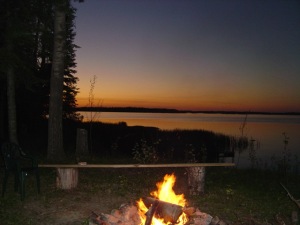 |
 |
Lake of the Woods County was named because the lake covers a large portion of the county. Jacques de Noyon, a Frenchman who came from Trois Rivières, (Quebec), explored this area in 1688 and became the first white man to view the lake. He named the lake Lac aux Îles which means “Lake of the Islands” in English.
In 1885 the region of Lake of the Woods got its first settler, Wilhem Zippel, who was a German immigrant and a fisherman. He settled on the south shore of the lake in a place now called Zippel Bay. Shortly after, Alonzo Wheeler settled on a point on the southwest side of the lake which is now called Wheeler’s Point.
A terrible wildfire, which has come to be known as the Baudette Fire of 1910, broke out in October of that year, burning 300,000 acres (1,200 km2) and destroying the towns of Spooner, Baudette, Graceton, Pitt, Williams, and Cedar Spur.[3] Lake of the Woods County was founded January 1, 1923, with Baudette as the original county seat. Lake of the Woods County is also known as Minnesota’s youngest county. This county was organized on November 28, 1922, when residents voted to separate the northern Townships.
 |
 |
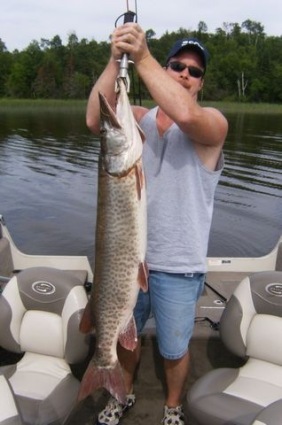 |
 |
On Saturday between throwing up on the boat, I managed to catch the largest fish of the trip. I only caught one fish while Darrell and Mark brought in a truck load.
On Sunday we packed up and headed home. We departed around 11:00 am on Sunday. I dropped them off in Sioux City around 3:00 pm and head home to Cedar Rapids, Iowa. They were kind enough to share their catches with me and I had enough fish for the next 3 weeks.
Lake of the Woods is a beautiful area with lots of wonderful lakes and luscious green trees. Fishing and Hunting are not my sports, but I love flying and traveling.
Please visit my WEB Site for more stories on flying at “FLY HIGH AND FAST”.
Written by jjmeehan13
May 21, 2010 at 3:03 pm
Posted in Flying
‘Fly High and Fast – Vol. II Chapter 26: The Twin Cities – Minneapolis & St. Paul, Minnesota
JJ Meehan
mfmeehan@live.com
Homepage
The Meehan Family
Two for the price of one. Minneapolis, Minnesota is a fantastic city by itself but you also get St. Paul which is another World Class City. Minneapolis is connected to St. Paul and both are fantastic places. Known as the TWIN Cities. The both have fantastic airports which are located close to the heart of the city. In addition they both have satellite airports that are handy to suburbs e.g., Crystal Airport in the north and Flying Cloud Airport in the west.
One chapter does not do either city proper but I mainly want to give you a taste of of the “Good” in both. Over the years I have flown into all the airports in the Twin Cities but without a doubt have spent more time at the Minneapolis International and St. Paul Airport than the airports in the suburbs.
As with many places I’ve visited, I have great memories of The Twin Cities. The great places to eat, the people, the beauty of the cities and the history of the area. The Twin Cities as well as all of Minnesota are know for hard working industrial people to are family oriented. In addition, I have used both as a hub when I was calling on banks in Minnesota between 1986 and 1991. You are with in an hour of several smaller towns and metropolitan areas
-
St. Cloud, MN
-
New Prague, MN
-
Mankato, MN
-
Northfield, MN
-
Red Wing, MN
-
Faribault, MN
.
Minnesota is known for hunting and fishing and the fact that a large portion of the population are descendents from Norway. They are know for their ability to handle the cold and are considered to be strong and hardworking. The town of New Prague traces it’s beginning to Prague in the Czech Republic. The town architecture has the beauty of Prague.
The TV series, “Coach” was based on a college team from Mankato, MN. The coach in the TV series was Hayden Fox who’s character was based on the coach for the University of Iowa – Hayden Fry.
Northfield, MN is best know for being the place where Jesse James and the Younger Brothers tried to rob the First National Bank on September 7th, 1896. The town had been tipped off and were waiting for the outlaws.
Much to the outlaws’ surprise, the people of Northfield not only refused to cooperate with the robbery, they shot back. A lot of them shot back. With deadly accuracy. And they organized huge posses that didn’t give up but kept after them for days and weeks. As many as 2000 men chased them for weeks. This just didn’t happen to them in Missouri. The guns the Northfield townspeople grabbed quickly to use may have been old or in poor working order, but they had an advantage of range over the handguns the robbers used. It’s worth noting, though, that despite accounts written at the time mocking the apparent poor marksmenship of the Missouri robbers, the outlaws were very pointedly trying not to kill anyone. Cole Younger later said, “Chadwell, Woods and Jim rode up and joined us, shouting to people in the street to get inside, and firing their pistols to emphasize their commands. I do not believe they killed any one however… Every time I saw any one with a bead on me I would drop off my horse and try to drive the shooter inside…” The townspeople, on the other hand, were shooting to kill.
New Praque, MN
Mankato, MN

Faribault, MN
St. Cloud, MN
Red Wing, MN
Fleeing the town under heavy gunfire, with no money, the James brothers, Frank and Jesse (presumably), and the Younger brothers (Cole, Jim, and Bob), along with Charlie Pitts, left behind two dead gang members, and two dead townspeople. Elias Stacy shot Clell Miller with a shotgun loaded with birdshot. A shot from Dr. Henry M. Wheeler killed him. Anselm R. Manning, armed with a finicky breach-loading rifle killed Chadwell/Stiles. Cole Younger was shot in the thigh; Bob Younger had his right elbow shattered. You can read the who story at Jesse James and the Younger Brothers tried to rob the First National Bank.
Red Wing, MN has a large Indian Reservation and today is the home of a large casino – Treasure Island.
Faribault, MN is a town of just over 20,000 people about 50 miles south of Minneapolis. Faribault is regarded as one of the most historic communities in Minnesota, with settlement and commercial activity predating Minnesota’s establishment as a U.S. Territory. Prior to 1745, the area was primarily occupied by the Wahpekute band of Dakotah. Shortly thereafter, the tribe was driven south after several clashes with the Ojibwe over territory.
St. Cloud, MN is a town of about 60,000 people about 100 miles northwest of Minneapolis. Minnesota was organized as a territory in 1849. The St. Cloud area had been opened to legal ownership by non-Native Americans following treaty negotiations with the Winnebago tribe in 1851 and 1852. St. Cloud was a waystation on the Middle and Woods branches of the Red River Trails between the Canadian border at Pembina and St. Paul. The cart trains often consisted of hundreds of ox carts; the carters would camp west of the city and cross the Mississippi in St. Cloud or in Sauk Rapids, just to the north.
The City of St. Cloud was incorporated in 1856. It developed from three distinct settlements, known as Upper Town, Middle Town, and Lower Town, that were established beginning in 1853.[11] The remnants of the deep ravines that separated the three are still visible today. Middle Town was settled primarily by Catholic German-Americans, who were attracted to the region by Father Francis Xavier Pierz. Lower Town was founded by settlers from New England and the mid-Atlantic states. Upper Town, or Arcadia, was plotted by General Sylvanus Lowry, a slave-holding Southerner from Kentucky. Lowry was St. Cloud’s first mayor, serving only one year.
The people and the towns of Minneapolis are similar to other towns in the Midwest when it comes to hospitality. Without any doubt you will find friendly people and clean info structures. The cities are all interesting to visit and have their own history. The people are all wonderful.
Twin Cities
The twin Cities of Minneapolis and St Paul are the focus of this blog and are the hot spots of Minnesota when it comes to Food, Entertainment and Excitement. There is no place like it when it comes to being able to enjoy the best in Theaters, Dining and Shopping. The Mall of America is the largest shopping mall in the USA.
The twin cites has it all. Many years ago, I can remember visiting Minneapolis with the solo purpose of seeing Duran Duran. My daughter really liked the band and we planned a three day trip to Minneapolis with the band being the main attraction. Sad to say, they cancelled their performance and we did not get to see them but there was so much more to enjoy that we really never thought twice about not seeing them. At least my wife and I did not. Our daughter may have a different view of the situation. We went to the Zoo, Valley Fair (Amusement Park) and shopped. We also enjoyed several of the fine restaurants in the Twin Cities. The following are a few pictures of the Minneapolis area.
 |
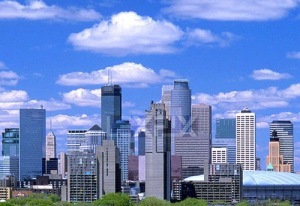 |
 |
 |
 |
 |
St. Paul is like Kansas City. It is a large town with a the heart of a small community. The capital of Minnesota is located in St. Paul. St. Paul is also the home of one of the few Basilica’s in the USA. This always held a special place in my heart since Jeannie and I were married in a Basilica – The Basilica of St. Francis Xavier in Dyersville, Iowa. The Basilica of St. Mary’s is located on the the west edge of St. Paul just before you enter Minneapolis.
 |
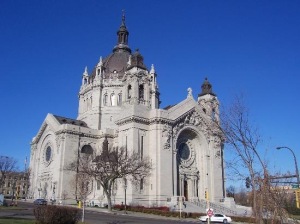 |
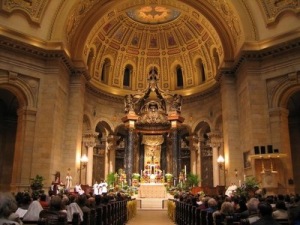 |
 |
The Basilica of St. Mary’s is gorgeous and is not only an architectural wonder but a beautiful piece of art. The workmanship is outstanding and future generations will have years of enjoyment from the Basilica.
The Capital is located just a few blocks from the Basilica and is also an architectural wonder.
St. Paul is a fun city with lots of great restaurants. Each year they hold a Winter Carnival and the best of the best display their Ice Sculptures.
 |
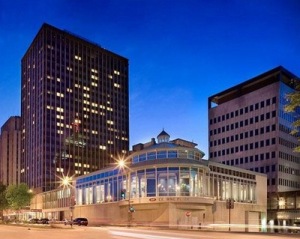 |
 |
 |
If all my many trips to St. Paul, maybe the one that stands out the most was a charter for CMF&Z. We flow up early on in the morning and I spent most of the day sightseeing around St. Paul. It was the middle of winter and as night approached the temperatures dropped to records of –40 F degrees (-40 C ). This was one of the few times where the Fahrenheit and Celsius have ever been the same. It was so cold that I had them put the plane in a heated hanger and I made sure that the engines were warm before we started our take-off roll. The air was so clear that you could see Rochester, MN which was 60 miles to the south as we climbed through 5,000 ft. I was very glad to get home to a warm bed around 1:00 am.
I hope you get a chance to visit the Twin Cities. Thanks for reading my blogs.
You can read our other blogs on flying on our WEB Site – “FLY HIGH AND FAST”.
Written by jjmeehan13
May 20, 2010 at 12:16 pm
Posted in Flying
Fly High and Fast – Vol. I: Chapter 7 – SR-71 Blackbird
JJ Meehan
mfmeehan@live.com
WEB Site
The Meehan Family
The Lockheed SR-71 is an advanced, long range, Mach 3+ strategic reconnaissance aircraft developed from the Lockheed A-12 and YF-12A aircraft by the Lockheed Skunk Works as a Black project. The SR-71 was unofficially named the Blackbird, and called the Habu by its crews, referring to an Okinawan species of pit viper. Clarence “Kelly” Johnson was responsible for many of the design’s innovative concepts. A defensive feature of the aircraft was its high speed and operating altitude, whereby, if a surface-to-air missile launch were detected, standard evasive action was simply to accelerate. The SR-71 line was in service from 1964 to 1998, with 12 of the 32 aircraft being destroyed in accidents, though none were lost to enemy action. Since 1976, it has held the world record for the fastest air breathing manned aircraft, a record previously held by the YF-12.
Development
Predecessors
The A-12 OXCART, designed for the CIA by Clarence Johnson at the Lockheed Skunk Works, was the precursor of the SR-71. Lockheed used the name “Archangel” for this design, but many documents use Johnson’s preferred name for the aircraft, “the Article”. As the design evolved, the internal Lockheed designation progressed from A-1 to A-12 as configuration changes occurred, such as substantial design changes to reduce the radar cross-section.
The first flight, by an A-12 known as “Article 121”, took place at Groom Lake (Area 51), Nevada, on 25 April 1962 equipped with the less powerful Pratt & Whitney J75 engines due to protracted development of the intended Pratt & Whitney J58. The J58s were retrofitted as they became available, and became the standard power plant for all subsequent aircraft in the series (A-12, YF-12, M-21) as well as the follow-on SR-71 aircraft.
Eighteen A-12 family aircraft were built. One was a pilot trainer with a raised second cockpit for an Instructor-Pilot and 12 were reconnaissance A-12s to be flown operationally by CIA pilots. Three were YF-12A prototypes of the planned F-12B interceptor version, and two were the M-21 variant.
SR-71
The A-12 OXCART, designed for the CIA by Clarence Johnson at the Lockheed Skunk Works, was the precursor of the SR-71. Lockheed used the name “Archangel” for this design, but many documents use Johnson’s preferred name for the aircraft, “the Article”. As the design evolved, the internal Lockheed designation progressed from A-1 to A-12 as configuration changes occurred, such as substantial design changes to reduce the radar cross-section.
The first flight, by an A-12 known as “Article 121”, took place at Groom Lake (Area 51), Nevada, on 25 April 1962 equipped with the less powerful Pratt & Whitney J75 engines due to protracted development of the intended Pratt & Whitney J58. The J58s were retrofitted as they became available, and became the standard power plant for all subsequent aircraft in the series (A-12, YF-12, M-21) as well as the follow-on SR-71 aircraft.
Eighteen A-12 family aircraft were built. One was a pilot trainer with a raised second cockpit for an Instructor-Pilot and 12 were reconnaissance A-12s to be flown operationally by CIA pilots. Three were YF-12A prototypes of the planned F-12B interceptor version, and two were the M-21 variant.
Design and operational details
A particularly difficult issue with flight at over Mach 3 is the high temperatures generated. As an aircraft moves through the air at supersonic speed, the air in front of the aircraft is compressed into a supersonic shock wave, and the energy generated by this heats the airframe. To address this problem, high-temperature materials were needed, and the airframe of the SR-71 was substantially made of titanium, obtained from the USSR at the height of the Cold War. Lockheed used many guises to prevent the Soviet government from knowing what the titanium was to be used for. In order to control costs, Lockheed used a more easily-worked alloy of titanium which softened at a lower temperature. Finished aircraft were painted a dark blue (almost black) to increase the emission of internal heat (since fuel was used as a heat sink for avionics cooling) and to act as camouflage against the night sky.[citation needed] The aircraft was designed to minimize its radar cross-section, an early attempt at stealth design. The call sign of the aircraft, “Blackbird”, signifies the resistance of its airframe to visible light and radar
Stealth
The SR-71 was the first operational aircraft designed around a stealthy shape and materials. There were a number of features in the SR-71 that were designed to reduce its radar signature. The first studies in radar stealth technology seemed to indicate that a shape with flattened, tapering sides would avoid reflecting most radar energy toward the radar beams’ place of origin. To this end, the radar engineers suggested adding chines to the design and canting the vertical control surfaces inward. The aircraft also used special radar-absorbing materials which were incorporated into sawtooth shaped sections of the skin of the aircraft, as well as cesium-based fuel additives to reduce the exhaust plumes’ visibility on radar. Despite these efforts, the SR-71 was still easily detected on radar while travelling at speed due to its large exhaust stream and air heated by the body (large thermal gradients in the atmosphere are detectable with radar). The SR-71’s radar cross section (RCS) was much greater than the later F-117’s RCS, which is on the order of a small ball bearing.
The overall effectiveness of these designs is still debated; Ben Rich’s team could show that the radar return was, in fact, reduced, but Kelly Johnson later conceded that Russian radar technology was advancing faster than the “anti-radar” technology Lockheed was using to counter it. The SR-71 made its debut years before Pyotr Ya. Ufimtsev’s ground-breaking research made possible today’s stealth technologies, and, despite Lockheed’s best efforts, the SR-71 was still easy to track by radar and had a huge infrared signature when cruising at Mach 3.2 or more. It was visible on air traffic control radar for hundreds of miles, even when not using its transponder. SR-71s were evidently detected by radar, as missiles were often fired at them.
Although equipped with defensive electronic countermeasures, the SR-71’s greatest protection was its high top speed, which made it almost invulnerable to the attack technologies of the time; over the course of its service life, not one was shot down, despite over 4,000 attempts to do so. All the pilot had to do when a SAM was fired was to accelerate.
Operational History
The first flight of an SR-71 took place on 22 December 1964, at Air Force Plant 42 in Palmdale, California.[45] The first SR-71 to enter service was delivered to the 4200th (later, 9th) Strategic Reconnaissance Wing at Beale Air Force Base, California, in January 1966.[46] The United States Air Force Strategic Air Command had SR-71 Blackbirds in service from 1966 through 1991.
SR-71s first arrived at the 9th SRW’s Operating Location (OL-8) at Kadena Airbase, Okinawa on 8 March 1968. These deployments were code named “Glowing Heat”, while the program as a whole was code named “Senior Crown”. Reconnaissance missions over North Vietnam were code named “Giant Scale”.
On 21 March 1968, Major (later General) Jerome F. O’Malley and Major Edward D. Payne flew the first operational SR-71 sortie in SR-71 serial number 61-7976 from Kadena AB, Okinawa. During its career, this aircraft (976) accumulated 2,981 flying hours and flew 942 total sorties (more than any other SR-71), including 257 operational missions, from Beale AFB; Palmdale, California; Kadena Air Base, Okinawa, Japan; and RAF Mildenhall, England. The aircraft was flown to the National Museum of the United States Air Force near Dayton, Ohio in March 1990.
From the beginning of the Blackbird’s reconnaissance missions over enemy territory (North Vietnam, Laos, etc.) in 1968, the SR-71s averaged approximately one sortie a week for nearly two years. By 1970, the SR-71s were averaging two sorties per week, and by 1972, they were flying nearly one sortie every day.
While deployed in Okinawa, the SR-71s and their aircrew members gained the nickname Habu (as did the A-12s preceding them) after a pit viper indigenous to Japan, which the Okinawans thought the plane resembled.
Swedish JA 37 Viggen fighter pilots, using the predictable patterns of SR-71 routine flights over the Baltic Sea, managed to lock their radar on the SR-71 on numerous occasions. Despite heavy jamming from the SR-71, target illumination was maintained by feeding target location from ground-based radars to the fire-control computer in the Viggen. The most common site for the lock-on to occur was the thin stretch of international airspace between Öland and Gotland that the SR-71 used on the return flight.

Operational highlights for the entire Blackbird family (YF-12, A-12, and SR-71) as of about 1990 included:
- 3,551 Mission Sorties Flown
- 17,300 Total Sorties Flown
- 11,008 Mission Flight Hours
- 53,490 Total Flight Hours
- 2,752 hours Mach 3 Time (Missions)
- 11,675 hours Mach 3 Time (Total)
Only one crew member, Jim Zwayer, a Lockheed flight-test reconnaissance and navigation systems specialist, was killed in a flight accident. The rest of the crew members ejected safely or evacuated their aircraft on the ground.
The highly specialized tooling used in manufacturing the SR-71 was ordered to be destroyed in 1968 by then-Secretary of Defense Robert McNamara, per contractual obligations at the end of production.[citation needed] Destroying the tooling killed any chance of there being an F-12B, but also limited the SR-71 force to the 32 completed, the final SR-71 order having to be cancelled when the tooling was destroyed.
Libya
In April 1986, following an attack on American soldiers in a Berlin disco, President Reagan ordered the bombing of Muammar Qaddafi’s terrorist camps in Libya . The SR-71 was order to fly over Libya , and take photographs recording the damage our F-111’s had inflicted. Qaddafi had established a ‘line of death,’a territorial marking across the Gulf of Sidra , swearing to shoot down any intruder, that crossed the boundary. On the morning of April 15, I rocketed past the line at 2,125 mph.
The SR-71 spy plane, the world’s fastest jet crossed into Libya , and were approaching their final turn over the bleak desert landscape, when the Recon Officer informed the Pilot, that he was receiving missile launch signals. the Pilot quickly increased their speed, calculating the time it would take for the weapons, most likely SA-2 and SA-4 surface-to-air missiles, capable of Mach 5 – to reach our altitude. He estimated, that they could beat the rocket-powered missiles to the turn, and stay on course, betting our lives on the plane’s performance.
After several agonizingly long seconds, they made the turn and blasted toward the Mediterranean . ‘You might want to pull it back,’ the Recon Officer suggested. It was then that Pilot noticed he still had the throttles full forward. The plane was flying a mile every 1.6 seconds, well above our Mach 3.2 limit. It was the fastest they would ever fly. he pulled the throttles to idle, just south of Sicily , but they still overran the refueling tanker, awaiting us over Gibraltar …
Typically they trained for a year, flying out of Beale AFB in California , Kadena Airbase in Okinawa , and RAF Mildenhall in England . On a typical training mission, they would take off near Sacramento, refuel over Nevada, accelerate into Montana, obtain a high Mach speed over Colorado , turn right over New Mexico, speed across the Los Angeles Basin, run up the West Coast, turn right at Seattle , then return to Beale.
Total flight time:- Two Hours and Forty Minutes.
One day, high above Arizona , an SR-71 was monitoring the radio traffic, of all the mortal airplanes below us. First, a Cessna pilot asked the air traffic controllers to check his ground speed. ‘Ninety knots,’ ATC replied. A Bonanza soon made the same request. ‘One-twenty on the ground,’ was the reply.
To their surprise, a navy F-18 came over the radio, with a ground speed check. I knew exactly what he was doing. Of course, he had a ground speed indicator in his cockpit, but he wanted to let all the bug-smashers in the valley, know what real speed was, ‘Dusty 52, we show you at 620 on the ground,’ ATC responded.
The situation was too ripe.
The pilot heard the click of the navigator’s mike button in the rear seat. In his most innocent voice, He startled the controller by asking for a ground speed check from 81,000 feet, clearly above controlled airspace. In a cool, professional voice, the controller replied, ‘Aspen 20, I show you at 1,982 knots on the ground.’ We did not hear another transmission on that frequency, all the way to the coast.
You can read our other blogs on flying on our WEB Site – “FLY HIGH AND FAST” at http://themeehanfamily.com/blogs/fly.htm.
Written by jjmeehan13
May 7, 2010 at 3:05 pm
Posted in Flying
Fly High and Fast – Vol. II Chapter 25: Austin Minnesota and Austin Texas
JJ Meehan
mfmeehan@live.com
Homepage
The Meehan Family
One of my most unique trips took place on a Wednesday in September, 1989. I was called at work to see if I could take a short trip up to Austin, Minnesota with a two executives of Hormel Meat Packing. My schedule was flexible at work and I said sure.
We left around 9:00 am from Wathan Flying Service at the Cedar Rapids Airport (CID) in Baron N6WW (Number Six Whiskey Whiskey). Austin is just about 100 Nautical Miles (NM) North, Northwest of CID. The weather was clear and I had some paper work to do while they were holding their meeting. Around noon I got a call from Wathan Flying Service to see if I could take another trip when I got back. I asked where and they said Austin Texas via Des Moines, Iowa. I called my Executive Assistant and verified that my schedule was open for the rest of the day and early on Thursday and called them back and said I would be glad to take the charter to Austin.
Austin Minnesota is the home of Hormel Meat Packing and the source of most the SPAM (Food) not E Mail sold in the world. There is even a SPAM Museum in Austin Minnesota.
My passengers got back around 1:00 pm and we were back in Cedar Rapids by 2:00 pm. I checked with the Trip Scheduler at Wathan Flying Service and got the rest of the information on the second trip. A group of Executives from an Insurance Company in Des Moines were going to Austin for a Meeting. Their company jet could not hold all the Executives and they did not want all the Executives on one plane. I’m not sure how they decided who would take the slow boat to China (The Baron) verses the Gulfstream Jet. The losers were to meet me at Elliot Flying Service in Des Moines at 4:00 pm. I have no idea who they were or their names. I can not even remember the name of the Company. I refueled and filed two flight plans. One from Cedar Rapids (CID) to Des Moines (DSM) and then one from (DSM) to Austin (AUS), Texas. The following shows you the routes of both flights. In one day I managed to be in both Austin, Minnesota and Austin, Texas.
Flight time from DSM to AUS was 3:00 non stop. Total Flight distance was 580 KM. The jet landed about 1:00 before we landed and had taken off after we did. They also had a tray of sandwiches that they ate in flight. Actually pretty good sandwiches from a catering service at the Des Moines Airport. N6WW was a beautiful plane to fly and held a good load but 5 passengers and sandwiches were almost more than we could handle. The luggage had gone on the jet – Thank God.
I love Austin, Texas and on this flight the area was prettier than ever. We arrived just as the Sun was setting in the West. The grass was very green and the water in the lakes around Austin sparkled like the jewels they were. Austin is names have Stephen F. Austin who is known as the Father of Texas. Austin took temporary command of the Texan forces during the Siege of Bexar from October 12 to December 11, 1835. After learning of the Disturbances at Anahuac and Velasco in the summer of 1835, an enraged Santa Anna made rapid preparations for the Mexican army to sweep Anglo settlers from Texas. War began in earnest in October 1835 at Gonzales. The Republic of Texas, created by a new constitution on March 2, 1836, won independence following a string of defeats with the dramatic turnabout victory at the Battle of San Jacinto on April 21, 1836, and the capture of Santa Anna the following morning.
 |
 |
 |
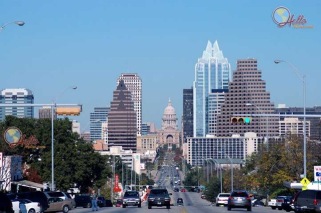 |
 |
 |
 |
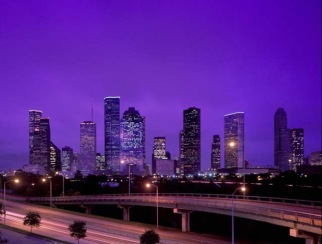 |
Austin, Texas is also the home of my cousin and a cousin of my wife. Br. Gerald Muller is a noted author and a teacher at St. Edwards University in Austin. Br. John Terlisner is a retired Math Teacher and he also resides at St. Edwards University in Austin. I was not able to visit with either gentleman on this trip but we do try to get together when possible.
It was after 9:30 pm before I got refueled and back in the air to Cedar Rapids, Iowa. This time I had a head wind and it took be just about 3:00 hours to get to Kansas City. I decided to refuel at the Kansas City Downtown Airport and also get a sandwich before heading on to Cedar Rapids. I was back in the air around midnight and I landed at 1:45 am. Austin to Austin in 16 hours. It was a long day. Glad to be home. The weather was VFR (Very good) all the way.
You can read my other blogs on flying on my WEB Site – “FLY HIGH AND FAST”.
Written by jjmeehan13
April 22, 2010 at 10:01 pm
Posted in Flying
Fly High and Fast – Vol. II Chapter 24: Rochester, Minnesota
JJ Meehan
mfmeehan@live.com
Homepage
The Meehan Family
The Beechcraft Baron 58 is a fast aircraft with a cruise speed of 190KTs. In the summer of 1988 a friend, Jim Menke, asked if I could fly his family up to Rochester Minnesota to visit his wife’s father who was in St. Mary’s Hospital in Rochester. Jim had rebuilt our home over the years and was a friend since college. I was more than glad to help him.
At the time I was flying charter part time for Wathan Flying Service and they had a Baron 58 available for the trip. It was my old friend N6WW.
We departed on a Wednesday night after work. Jim would be in the Co-Pilot Seat and his wife and 4 children would be in the back. Sharon (Jim’s Wife) was holding the baby.
Rochester, Minnesota is 120 KM north of Cedar Rapids and the flight time in the baron is about 45 minutes from the ramp to ramp. The airport in Rochester is a complete service airport and is even used by Northwestern (Delta) for practice approaches. It is located about 60 KM south of Minneapolis and St. Paul Minnesota.
We had a little head wind on the flight up to Rochester but we still managed to be on the ground in 1 hour from the time we take-off. The airport is south of the city and we took a curtsey car into the hospital. Many of the Fix Base Operators (FBO’s) have curtsey cars available for the pilots when they land. St. Mary’s Hospital is downtown about 4 blocks from Mayo Clinic.
This was not my first trip to Rochester nor my last. My first trip was with Tom Anderson from Banks of Iowa Computer Services and is documented in an earlier blog – Fly High and Fast – Vol. II Chapter 7 – Flying IFR with Low Ceilings. Then there were several trips with Flight Students, several trips prospecting and a few charters. Rochester, MN is a beautiful city with a World Class Health Clinic – Mayo Clinic. St. Mary’s Hospital is part of this organization. I went to the Mayo Clinic to renew my Airline Pilot Medical at one point and was very impressed by the detail physical and the personal that I met. I’ve tried to capture the beauty of the city in the pictures to the left and below. Most of these are from the Internet but they do a great job of capturing the beauty of this modern city, which is also the home of IBM.
Jim and Sharon Menke are fantastic people and have raised a wonderful family. This was a chance for them to bring their family to Rochester, MN to visit with Sharon’s parents. As with many families from the Midwest, there is a special bond that develops and you could see this bond during our flight and at the hospital. I’ve seen this bond with my work on Genealogy in Ireland and I believe is one of the reasons I’m so intrigued by Genealogy and Families. You can read my blogs on Ireland at http://home.earthlink.net/~mfmeehan/jjm/ireland.htm. You can read my data on My Family Genealogy and other families at http://home.earthlink.net/~mfmeehan/jjm/gen.htm. Families and friends are special and I was more than glad to have the opportunity to be part of the Menke Family for a short while.
Jim and I attend Loras College in Dubuque, Iowa for two years. He then moved to Lincoln Nebraska, attend both the University of Nebraska and the State University of Iowa before going to work at Rockwell Collins. I graduated from Loras College and went to work at Rockwell Collins for a few years before joining Banks of Iowa Computers Services (BICS). We have been friends for a very long while. You can read the blog on another friend and classmate, Ensign Larry Ryan at http://home.earthlink.net/~mfmeehan/jjm/lr.htm. I have been blessed with a lot of friends and a few have really stood out. Both Larry and Jim are two of those friends. I’m getting away from my story of our flight to Rochester, MN but I thought you should have some background.
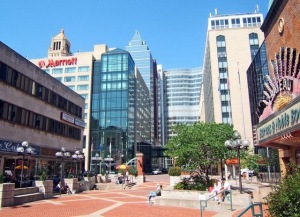 |
 |
 |
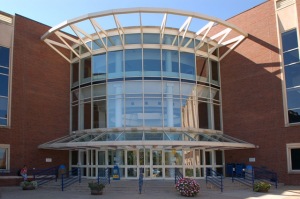 |
 |
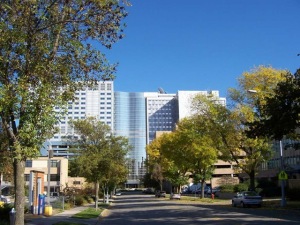 |
 |
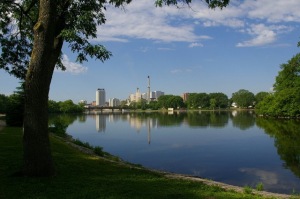 |
We were back to the airport and in the air by 9:00 pm. The weather had turned bad as a cold front was moving through the area. The ceilings at both Cedar Rapids and Rochester had dropped to below 500 ft and one mile visibility. Des Moines Iowa was my closest alternate if I needed it. We climbed to 7,000 feet and were in the clouds for the full flight from the time we left the ground at Rochester. Because of our location we were handled by Rochester Departure who then handed us off to Waterloo Approach. Waterloo took good care of us until we were handed off to Cedar Rapids Approach for the ILS 9 at Cedar Rapids (CID). The weather was down to minimums – 200 ft and 1/2 mile in visibility when we arrived at CID. The approach was normal and again we show what you see in the video to the right. We were on the ramp and heading to the cars by 10:30 pm. Not bad for a trip that would have taken 3 1/2 hours of driving each way.
You can read more blogs by me on flying at “FLY HIGH AND FAST”,
Written by jjmeehan13
April 22, 2010 at 1:38 am
Posted in Flying
Fly High and Fast – Vol. II Chapter 28: Kansas City, Kansas and Washington, Missouri
JJ Meehan
mfmeehan@live.com
Homepage
The Meehan Family
One of my first long trips and one of my trips to Missouri took place with my friend Gene Knoernschild in 1975. We were flying N6419U. Gene needed to drop off one of his children in Kansas City, Kansas and pick-up another in Washington, Missouri. He asked me if I would like to fly the aircraft so that he could work on the flight plans for each leg as we flow. there was no need to ask twice.
Gene was an excellent pilot and a good friend. We departed early on a Saturday afternoon for Fairfax Airport in Kansas City Kansas. At the time the Kansas City Downtown Airport was being used by TWA as their hub for the middle part of the USA. Fairfax Airport was located just across The Missouri River from Kansas City Downtown. It was decommissioned in 1985.
I had just gotten my instrument rating and this would be my first instrument cross country. The weather was forecasted to be clear during the first part of the flight but turn IFR by the later part. Total Flight time was 5 hours and 30 minutes. We flow the route using VOR points for navigation. VOR is short for VHF omnidirectional radio range which is a type of radio navigation system for aircraft. A VOR ground station broadcasts a VHF radio composite signal including the station’s identifier, voice (if equipped), and navigation signal. The identifier is morse code. The voice signal is usually station name, in-flight recorded advisories, or live flight service broadcasts. The navigation signal allows the airborne receiving equipment to determine a magnetic bearing from the station to the aircraft (direction from the VOR station in relation to the Earth’s magnetic North at the time of installation). VOR stations in areas of magnetic compass unreliability are oriented with respect to True North. This line of position is called the “radial” from the VOR. The “intersection” of two radials from different VOR stations on a chart provides an approximate position of the aircraft. You can read more about VOR Navigation at http://en.wikipedia.org/wiki/VHF_omnidirectional_range.
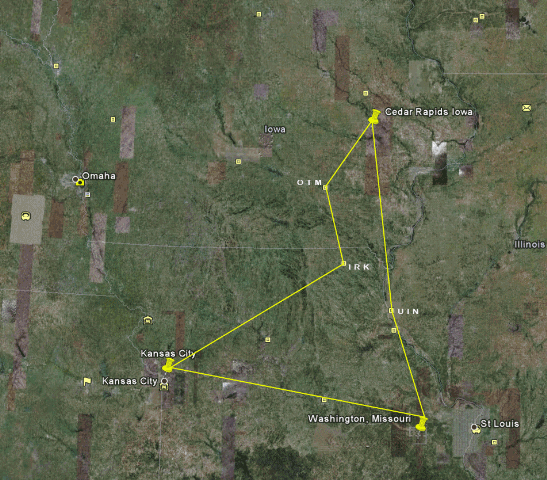 The first leg of our flight would be Cedar Rapids to Ottumwa (OTM), Kirksville, (IRK) and finally Fairfax Airport in Kansas City, Kansas.
The first leg of our flight would be Cedar Rapids to Ottumwa (OTM), Kirksville, (IRK) and finally Fairfax Airport in Kansas City, Kansas.
Fairfax Airport was decommissioned in 1985. You can still see some of the runway to the northwest and southeast of the plant shown in the picture below. The airport was best know for being the construction site of the B-25 Mitchell Bomber.
The airport was directly across the Missouri River from Kansas City Downtown Airport and served as an air strip for plane manufacturers and repairs in the city’s Fairfax district, as well as postal delivery. Passenger service in the area was handled by its Missouri sister (although Braniff briefly used it). Its IATA designation was KCK.
The airport was used by Harry Truman when he flew back to Missouri during his Presidency.
Shortly after this flight I would have an opportunity to make another flight to Fairfax Airport with my good friend Richard Bartholomew (Bart). Bart and I graduated from Denison High in Denison, Iowa and a classmate of ours was going to medical school in Kansas City. His name was Tony Clark. We went out for BBQ at one of the local restaurants and then bar hopping – Fantastic time.
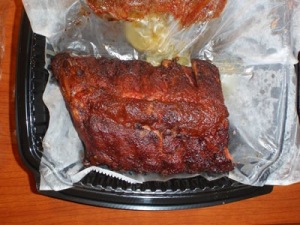 |
 |
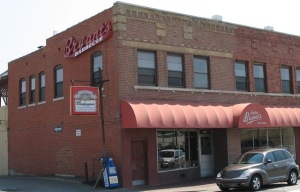 |
 |
Back to the flight with Gene Knoernschild and his children. We dropped off the one child with his grand parents after a few minutes of introduction and we were in the air again within 30 minutes. Next stop was Washington, Missouri.
Washington, Missouri
Washington began as a Missouri River boat landing. The St. Johns settlement from which it grew was at the extreme western edge of the frontier when Lewis and Clark’s “Corps of Discovery” camped nearby in May of 1804.
By 1818 when Franklin County was formed, thousands of American settlers had already arrived. Many of these were friends, family and followers of Daniel Boone and his sons who came to the area in 1799. Daniel Boone served as the Spanish syndic (judge) on the north side of the River. The first ferry in the area was licensed to run in 1814. It connected the settlements of La Charrette and Marthasville on the north bank to the Franklin County settlements.
In 1824 a German attorney named Gottfried Duden settled across the river along Lake Creek. He visited the Washington landing and became acquainted with Nathan Boone, Elijah McLean and other pioneers. He was investigating the possibilities of settlement in the area by his countrymen. In 1827 he returned to Germany which he felt was overpopulated. There he published a glowing “Report on a Journey to the Western States of North America” in 1829.
By that time the town of Union had been founded, and the County seat had been moved there from New Port in 1826. On the Missouri River, the Washington Landing was becoming more important for slave holding families to ship their tobacco and other crops. William G. Owens, Franklin County’s leading public official, saw a great future for the landing site and purchased the site and land nearby in 1827 in order to found a town. In 1829, lots for a new town called Washington were offered for Public Sale on the Fourth of July. Owens offered a lot free to anyone who would build a substantial house within two years. His wealthy friend, Dr. Elijah McLean bought 80 acres west of the town’s borders.
By 1832 there were two German residents who had built homes on Owens’ promise, Bernhard Fricke and Charles Eberius. In October of 1833 a group of twelve Catholic families arrived by steamboat at Washington. These farmers from the Osnabrück area of Hanover had heard and read of the Missouri valley described so favorably by Gottfried Duden. They were welcomed by Owens and Fricke and bought land in the vicinity on which to settle.
Then on November 16, 1834 Wm. G. Owens was shot in the back and died. With his death the legal affairs of the young town were thrown into turmoil. On October 8, 1836 a rival town named Bassora was started just east of Washington. In 1837 a Post Office was first established at Washington, but then moved to Bassora. Soon German born John F. Mense, son-in-law to Owen’s widow Lucinda, managed to untangle Washington’s legal affairs which were tied up in probate. On May 29, 1839 the town sometimes later referred to as “New Washington” began again, and the Post office moved back in 1840.
After 1833 the German population of Washington area grew rapidly. Anti-slavery Germans were overtaking the population of wealthy slave owners. In 1834 groups of Germans from Giessen led by Friedrich Muench, and Soligen led by Frederick Steines, would fill the nearby hills and valleys. Their letters written home to friends and relatives brought more of their countrymen to the Missouri valley.
After the first years preoccupied with carving new homes out of the wilderness, the German pioneers craved cultural items such as books and musical instruments. Books were the items most requested in the letters back home where German encyclopedias, textbooks, bibles and hymnals, were sent from the “Old World” to enlighten the New.
On February 9th, 1855 the Pacific Railroad came to town and Washington experienced a boom. Steamboat ferries connected the town with its neighbors of North Washington, Dutzow, and Marthasville across the river. Brick buildings were built all over town, giving Washington the nickname of “brick town of Missouri.” In 1856 the town’s first newspaper “The Franklin Courier” appeared in both English and German. Cultural groups such as the theatrical society called the Players’ Club and the Turn Verein were forming by 1859. Washington’s “Busch’s Brewery” had been established in 1854 by German born John B. Busch, older brother of the St. Louis brewer. By 1860 all of the town’s Trustees but one were German. These German Americans were strongly supportive of the new homeland, which would be important to Missouri’s role in the civil war.
Federal forces during the Civil War controlled both the Missouri River and the Pacific Railroad. The Union Army’s 54th and 55th Regiments of the Enrolled Missouri Militia numbered over 2,000 troops raised in Franklin County. Also formed here were the 17th Missouri Regiment. But when Confederate Gen. Sterling Price, staged his last campaign to recapture Missouri – known as Price’s Raid- there were only about 600 troops stationed at Washington
 |
 |
 |
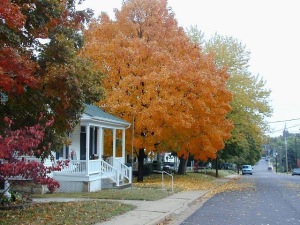 |
On September 28th, 1864, Union General Rosecrans at St. Louis wired Capt. Julius Wilhelmi, warning him of the approach of General Sterling Price and his troop of 10,000 men. Fearing the enemy too strong for their small number, the Militia and the townspeople retreated to the north side of the river by ferryboats and skiffs. The night of October 1st Price’s men camped at the Detweiler’s place east of Washington. They moved into Washington the next day and plundered the town for food, forage and usable horses. The railroad depot was set afire. A teamster John Henry Uhlenbrock and a young man named Bartsch were shot. After satisfying its appetite for supplies, the army moved westward towards Missouri’s capital, Jefferson City.
After the war, son of the town’s slaveholding founders, Franklin County’s State Representative James W. Owens, was instrumental in drafting the State’s proclamation abolishing slavery. The town then entered a postwar period of creativity, industry, and prosperity – a “Golden Era.” Franz Schwarzer arrived in Washington in 1865, where he would soon open a zither factory that would turn out International Award winning instruments by 1873. That same year, at Washington’s first Agricultural and Mechanical Fair, James Jones won the horse race and the pewter pitcher trophy. In 1884 Joseph A. Bayer started his pottery using locally mined clay. The next year Henry and Anton Tibbe devised the manufactured corn cob pipe which would bring their family worldwide fame and fortune.
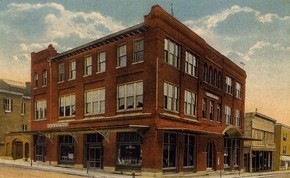 |
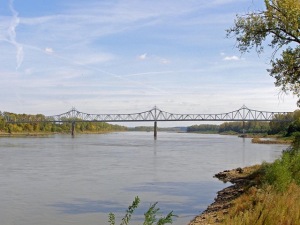 |
The new “grammar” school was built in ornate architectural style in 1871, after many years of using the second floor of the Town Hall for classes. A citywide waterworks opened in 1889 with a power plant at the foot of Jefferson Street. Next Anton Tibbe built an electric light plant and on New Year’s eve, 1892 officially “turned on the lights” in Washington. By February 1893 audiences were crowding Turner Hall to enjoy its plays and parties by the light of the new incandescent lamps. The “Independent Telephone Company” another Tibbe enterprise, was organized a few years later.
By the turn of the century Washington was serving its bi-cultural inhabitants and the surrounding territory as a commercial and social center. The pioneer families from the old South had blended with those of more recent vintage to form a vital population prepared for the challenges of the next century.
After picking up Gene’s daughter we headed home. The trip home was totally IFR. We flow to Quincy, IL (UIN) and then Cedar Rapids. At Cedar Rapids I shot my first ILS Approach which the following video to the right will give you a feel for what I experienced. Gene was a huge influence on my ability to learn how to fly correctly and safely. He was a great Engineer, Parent and Teacher.
You can see my other blogs on flying on my WEB Site – “FLY HIGH AND FAST”.
Written by jjmeehan13
April 21, 2010 at 11:09 am
Posted in Flying
‘Fly High and Fast – Vol. II Chapter 30: Missouri – St. Louis, Kirksville, Kansas City
JJ Meehan
mfmeehan@live.com
Homepage
The Meehan Family
The summer of 1987, we ((my family) took a very nice vacation and covered a lot of ground in 5 days.
The trip started from Cedar Rapids on Thursday in Baron N6WW. This aircraft was owned at the time by Wathan Flying Service where I was flying charters. It was one of several aircraft that I also used in my business at Banks of Iowa Computer Services (BICS). The Baron was a very nice plane with a good cruising speed (190 KTS) and very good load capacity. I first started flying the Baron when we needed to deliver work around Iowa and the surrounding states because we missed the scheduled Courier Service during time when we were installing new software. At the time we would process the work for banks around Iowa and the surrounding states during the hours between 8:00 pm and 5:00 am. Starting at 5:00 pm Courier Services would pick up the completed work and deliver it to the different banks. During this period of about 9 months we missed the Courier Service more times than we made it. I would then arrange to fly the work to the banks. I’ve covered this in another chapter.
Back to this specific trip. We departed from Cedar Rapids in Baron N6WW on Thursday morning around 9:00 am. For the next two days we would be starting at the Holiday Inn outside of Six Flags in St. Louis and visiting the Six Flags Amusement Park. On Saturday we would fly up to Kirksville and pick up Ken Turner for a trip to Kansas City for a Bank Group Meeting, a Baseball Game at the Kansas City A’s Stadium and two days at Worlds of Fun Amusement Park in Kansas City. The map below gives you an idea of the flight route and the area we covered in five days.

The flight to St. Louis was only 1:20. At the time there was a small airport near Six Flags which made it handy to land and then drive the few miles to Six Flags Amusement Park. The family took the trip pretty well and we were able to get to Six Flags by noon. For the next 2 days we had a fantastic time and took in all the rides at Six Flags. The following are a few of the pictures.
 |
 |
 |
 |
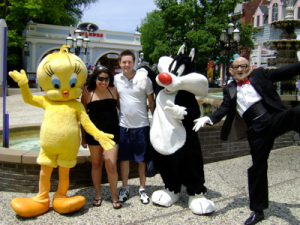 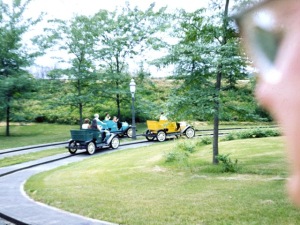 |
 |
We had a fantastic time and on Saturday Morning we took off for Kirksville, Mo. We picked up Ken Turner, his wife, Katherine and headed for Kansas City. Flight time was 50 minutes to Kirksville, Mo and and then another 50 minutes to Kansas City, Mo. We arrive around 11:00 am and headed for the Kansas City Royals Baseball Stadium. The Royals were playing the New York Yankee’s and Ken Turner had gotten us tickets to see the game from one of the private booths in the Stadium.
Weather was perfect and the game was fantastic. We were on the 3rd Base side and the view was exquisite.
 |
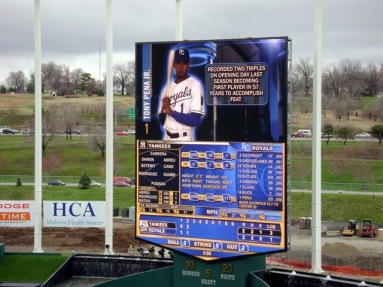 |
 |
 |
After the game we headed to the WESTIN Hotel for Meeting of the Missouri Bankers Association. Ken was being honored as the Past President of the Association. The Westin is located in the Crown Center which is part of the Hallmark Center in Kansas City.
We had dinner in the restaurant on top of the Westin after the meeting. On Sunday after breakfast we headed to Church. There is a little Catholic Church about 1 1/2 miles south of the complex.
Ken Turner had given us two tickets for Worlds of Fun. He and his family were heading to Oklahoma on an airline to visit their daughter and we were going to spend the next two days at Worlds of Fun.
After Church we drove the 20 miles to Worlds of Fun and had another great time and managed to take in most the rides and events.
Below are just a few photos of Worlds of Fun. I downloaded a couple from the Internet try and give you a good idea of how Worlds of Fun is laid out.
 |
 |
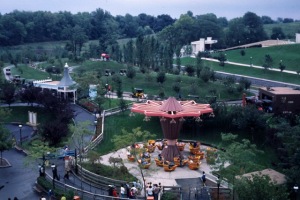 |
 |

|
By Monday night we were more than ready to head home to Cedar Rapids. Two amusement parks, one ball game is not bad for a five day vacation, especially when you consider the fact that the two amusement parks were at opposite ends of the state. N6WW served us well. No unusual experiences on this trip.
Please visit my other blogs on flying on my WEB Site – “FLY HIGH AND FAST”.
Written by jjmeehan13
April 20, 2010 at 2:53 pm
Posted in Flying
Fly High and Fast – Vol. II Chapter 29: Missouri – Kirksville
JJ Meehan
mfmeehan@live.com
Homepage
The Meehan Family
Kirksville, Missouri is the home of Northeast Missouri State University and one of the nicest small towns in the USA. In the fall the population of Kirksville increases by about 200% when the college students return to town. I spent many nights in Kirksville and the surrounding area between 1980 and 1991.
When I first visited the First National Bank (FNB) of Kirksville, Ken Turner was President. Ken is a true southern gentleman with a heart of gold. We both love flying and life. Ken and I became very good friends over the next few years and he gave me more than I have ever been able to repay.
Let’s start at the beginning. I stopped into the bank one summer day to see if there was any interest in making a change in their data processing center. At the time they were using a center out of Decatur, IL. During the conversation, Ken and I started talking about flying. He owned a V-35 Bonanza and we became instant friends.
FNB would become one of our primer customers and would be the link that would bring in other banks in Missouri.
I was blessed with a Program Manager who had gone to school at the Northeastern State University and was able to show me all the best bars and restaurants. Melinda Powers was a very out going gal who was very good at what she did. Thanks to her effort the conversion at the FNB went very smoothly. We enjoyed the college town atmosphere and the great bars and eating places of Kirksville and not only developed great friends in Kirksville but a very loyal customer. Melinda would later married a gentlemen who would become President of another bank in Iowa.
Ken would leave FNB shortly after we started the conversion and became President of the Bank of Lancaster, Missouri which was just up the road from Kirksville. The Bank of Lancaster also became a customer and Ken and developed a very close friendship. In the years that we processed for the banks, Ken and I would make many flights back to Cedar Rapids, over to Kansas City and down to St. Louis to visit his Correspondent Banker with the hope of finding new leads to other banks in Missouri. One of my favorite trips was to Oshkosh EAA Air Show which we covered in Chapter 18. Ken was also a Past President of the Missouri Bankers Association.
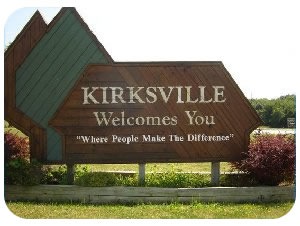 |
 |
 |
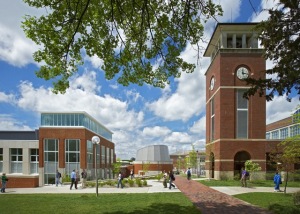 |
 |
 |
On one of my many flights in July the temperatures were around 110 (F) 43 (C ) degrees and I had been visiting banks all over Missouri. Ken and I were planning dinner on this specific night. It was hot and I was in a hurry and for some reason did not check put my landing gear down. I have developed the habit of always checking gear down on short final and on this day I almost did not check because again I was in a hurry and it was hot. On the Baron and Bonanza’s the gear handle is in front of the right passenger seat (Co-Pilot seat). In addition the Yoke comes out of the center firewall and you can not see the position of the gear handle without physical moving your head over and looking. On this day I was shocked to see that the gear was still up and we were about 50 feet from touching down. I quickly gave it full power and went around for a second approach and landing. This time the gear was down. The following is a very good view of the airport as you would turn final from a right base for runway 18..
Without a doubt this was another of my nine lives. For those who have not been reading all my blogs, I have decided that God gave me nine lives (Cat Lives). I have no doubt that I have used up all my lives and I’m current living on borrowed time.
Ken is now living in Joplin, Mo and we still stay in touch. I owe him more than he will ever know. In the next chapter I will talk about our trip to St. Louis, Kirksville, and Kansas City.
Please remember you can read more blogs on Flying by going to my WEB Site “Fly High and Fast”.
Written by jjmeehan13
April 19, 2010 at 11:50 am
Posted in Flying
